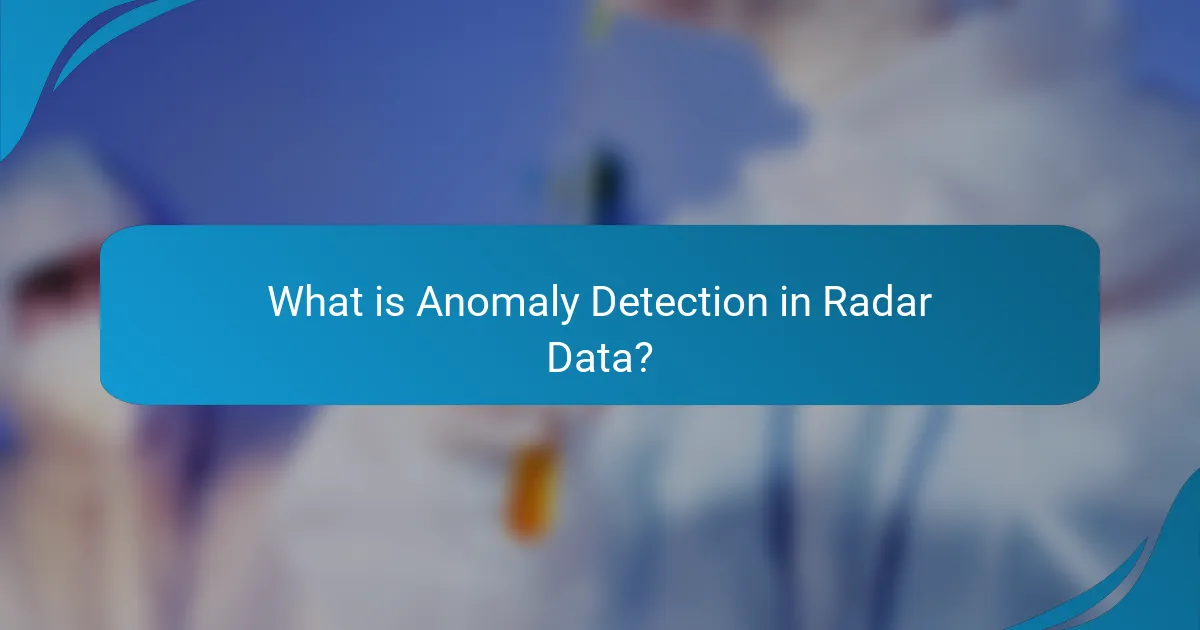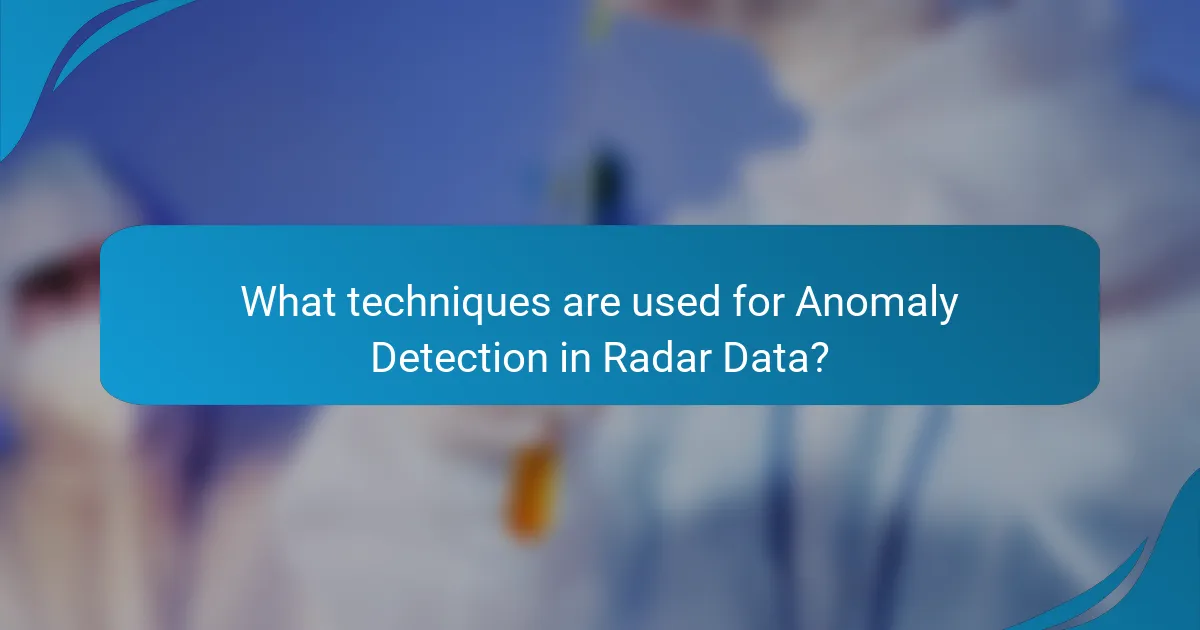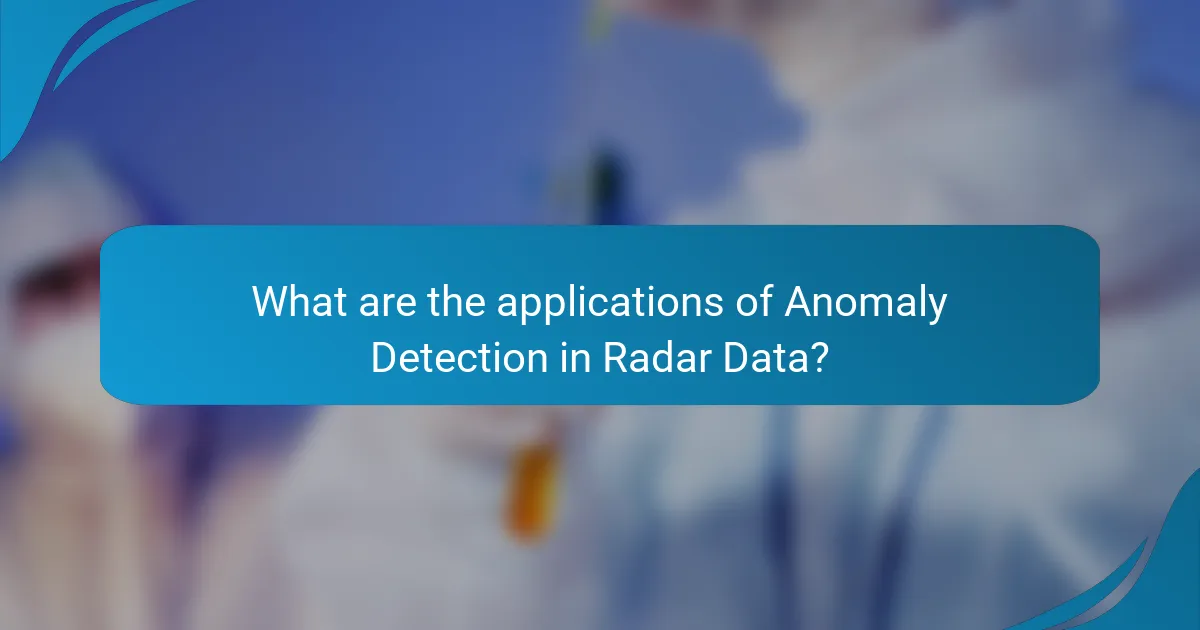Anomaly detection in radar data involves identifying unusual patterns or behaviors within radar signals, which is essential for applications such as surveillance, object tracking, and air traffic control. This process employs various techniques, including statistical analysis, machine learning algorithms, and signal processing methods, to effectively detect anomalies. Applications of anomaly detection span multiple sectors, including air traffic safety, military surveillance, weather monitoring, automotive systems, and maritime security. By enhancing operational safety and efficiency, anomaly detection plays a critical role in managing radar data across diverse industries.

What is Anomaly Detection in Radar Data?
Anomaly detection in radar data refers to the identification of unusual patterns or behaviors within radar signals. This process is crucial for various applications, including surveillance, object tracking, and air traffic control. Techniques such as statistical analysis, machine learning, and signal processing are commonly employed to detect anomalies. For instance, radar systems may analyze signal variations to spot unexpected movements or objects. The effectiveness of anomaly detection can significantly enhance operational safety and efficiency in radar applications.
How does Anomaly Detection in Radar Data function?
Anomaly detection in radar data functions by identifying patterns that deviate from expected behavior. It utilizes algorithms to analyze radar signals and detect unusual events. Techniques such as statistical analysis, machine learning, and signal processing are commonly employed. These methods can classify radar returns and flag anomalies based on predefined thresholds. For instance, if a radar signal shows an unexpected object trajectory, it is marked as anomalous. This process enhances situational awareness in applications like air traffic control and military surveillance. Studies have shown that effective anomaly detection can significantly reduce false alarms and improve response times in critical situations.
What are the key components of Anomaly Detection in Radar Data?
The key components of anomaly detection in radar data include data preprocessing, feature extraction, anomaly scoring, and validation. Data preprocessing involves cleaning and normalizing radar signals to remove noise and irrelevant information. Feature extraction identifies significant patterns or characteristics within the radar data, such as signal strength or frequency variations. Anomaly scoring assigns a numerical value to potential anomalies based on their deviation from expected patterns. Validation assesses the accuracy of detected anomalies through techniques like cross-validation or expert review. These components work together to effectively identify unusual patterns in radar data, ensuring reliable detection of anomalies.
How do these components interact in the detection process?
In anomaly detection in radar data, components such as signal processing, feature extraction, and machine learning interact to identify unusual patterns. Signal processing techniques filter and preprocess radar data to enhance signal quality. This improved data is then analyzed through feature extraction, which identifies key characteristics relevant to detecting anomalies. Machine learning algorithms utilize these features to classify data and recognize deviations from normal behavior. The interaction among these components creates a robust framework for detecting anomalies effectively. Each component relies on the output of the previous one to enhance overall detection accuracy.
Why is Anomaly Detection important in Radar Data analysis?
Anomaly detection is crucial in radar data analysis because it identifies unusual patterns that may indicate significant events. These events can include threats, system malfunctions, or environmental changes. Detecting anomalies allows for timely responses to potential security risks or operational issues. For instance, radar systems used in air traffic control rely on anomaly detection to spot unauthorized aircraft. Research shows that effective anomaly detection can enhance situational awareness and decision-making processes. Studies indicate that up to 30% of operational incidents can be attributed to undetected anomalies in radar data. Thus, anomaly detection improves the reliability and safety of radar systems.
What are the potential consequences of undetected anomalies?
Undetected anomalies can lead to significant operational failures. These failures may result in inaccurate data interpretation and decision-making. In radar data, undetected anomalies can cause misidentification of objects, leading to potential safety hazards. For example, a missed anomaly could result in a collision in air traffic control scenarios. Additionally, undetected anomalies may increase maintenance costs due to unforeseen equipment failures. Studies show that 70% of equipment failures are attributed to undetected anomalies. This highlights the importance of effective anomaly detection systems in preventing costly consequences.
How does Anomaly Detection improve decision-making in radar applications?
Anomaly detection enhances decision-making in radar applications by identifying unusual patterns in data. This capability allows operators to detect potential threats or system malfunctions promptly. For instance, radar systems can monitor aircraft movements, and any deviation from expected behavior can indicate a possible issue. By flagging these anomalies, decision-makers can respond quickly to prevent accidents or security breaches. Research shows that automated anomaly detection can reduce false positives by up to 30%, improving overall operational efficiency. Thus, integrating anomaly detection in radar systems directly supports timely and informed decision-making.
What types of anomalies can be detected in Radar Data?
Radar data can detect several types of anomalies. These include moving target detection, which identifies objects that are in motion against a static background. Another type is clutter detection, which distinguishes between actual targets and noise caused by environmental factors. Additionally, radar data can reveal unexpected changes in target behavior, such as sudden acceleration or deceleration. It can also identify false targets, which are erroneous detections caused by interference or malfunction. Moreover, radar systems can detect anomalies related to surface conditions, such as ice or debris on runways. Each of these anomalies can significantly impact operational safety and efficiency in various applications, including aviation and maritime navigation.
What are common examples of anomalies in radar signals?
Common examples of anomalies in radar signals include clutter, ghost targets, and multipath effects. Clutter refers to unwanted echoes from objects like terrain or weather. Ghost targets appear when radar signals reflect off multiple surfaces, creating false images. Multipath effects occur when signals bounce off various surfaces before reaching the receiver, distorting the data. These anomalies can lead to misinterpretation of radar information. Understanding these anomalies is crucial for accurate radar signal analysis.
How do different types of anomalies affect radar data interpretation?
Different types of anomalies significantly impact radar data interpretation. Anomalies can include noise, clutter, and unexpected targets. Noise can obscure genuine signals, making it difficult to identify true objects. Clutter, often from environmental factors, can mask or distort radar returns. Unexpected targets may lead to misclassification of objects, affecting situational awareness. Each anomaly type requires specific filtering techniques for accurate data interpretation. For instance, advanced algorithms can differentiate between noise and actual signals. Studies have shown that using machine learning techniques improves anomaly detection accuracy in radar systems.

What techniques are used for Anomaly Detection in Radar Data?
Anomaly detection in radar data utilizes several techniques. These techniques include statistical methods, machine learning algorithms, and signal processing approaches. Statistical methods often involve threshold-based detection, where data points are flagged if they exceed predefined limits. Machine learning algorithms, such as support vector machines and neural networks, learn from historical data to identify patterns and detect anomalies. Signal processing techniques, including Fourier transforms and wavelet analysis, help to analyze the frequency components of radar signals. Each technique has its strengths and is chosen based on the specific application and data characteristics.
What are the most common algorithms for detecting anomalies?
The most common algorithms for detecting anomalies include statistical methods, clustering techniques, and machine learning approaches. Statistical methods, such as Z-score and Grubbs’ test, identify outliers based on data distribution. Clustering techniques like k-means and DBSCAN group data points, flagging those that do not belong. Machine learning approaches, including Isolation Forest and One-Class SVM, learn from data patterns to detect anomalies. These algorithms are widely used in various applications, including fraud detection and network security. Their effectiveness is supported by empirical studies demonstrating their accuracy in identifying unusual patterns in datasets.
How do machine learning techniques enhance anomaly detection?
Machine learning techniques enhance anomaly detection by improving accuracy and efficiency in identifying outliers. These methods can learn from vast amounts of data, identifying patterns that traditional techniques may miss. For instance, supervised learning models can be trained on labeled datasets to recognize normal behavior. Unsupervised learning methods can detect anomalies without prior labeling, making them versatile in various applications. Techniques like clustering and neural networks adapt to new data, refining detection capabilities over time. Research shows that machine learning can reduce false positives by up to 30% compared to traditional methods. This adaptability is crucial in dynamic environments like radar data analysis, where conditions frequently change.
What role do statistical methods play in anomaly detection?
Statistical methods are essential in anomaly detection as they help identify patterns and deviations in data. These methods analyze data distributions to determine what constitutes normal behavior. When data points fall outside these established patterns, they are flagged as anomalies. Techniques such as hypothesis testing, regression analysis, and clustering are commonly used. For instance, the Gaussian distribution can model normal behavior. Any data point with a low probability under this model is considered anomalous. Studies show that incorporating statistical methods enhances detection accuracy. For example, the use of statistical control charts can effectively monitor process variations. Therefore, statistical methods provide a robust framework for identifying anomalies in various datasets.
How do various techniques compare in effectiveness?
Various techniques for anomaly detection in radar data exhibit different levels of effectiveness. Statistical methods often provide a baseline performance, detecting simple anomalies effectively. Machine learning approaches, like supervised learning, generally outperform statistical methods by adapting to complex patterns in data. Unsupervised learning techniques, such as clustering, can identify anomalies without labeled data but may struggle with false positives.
Deep learning methods, particularly convolutional neural networks, have shown superior performance in complex radar datasets. Research indicates that hybrid techniques, combining multiple methods, often yield the highest accuracy. For example, a study by Ahmed et al. (2016) demonstrated that ensemble methods improved detection rates by 20% compared to single techniques.
In summary, while traditional methods are useful, advanced machine learning and hybrid approaches tend to provide better effectiveness in anomaly detection within radar data.
What factors influence the choice of technique for specific applications?
The choice of technique for specific applications in anomaly detection is influenced by several factors. These factors include the nature of the data, the type of anomalies expected, and the computational resources available. The characteristics of radar data, such as noise levels and signal complexity, also play a crucial role. Additionally, the required detection speed and accuracy can dictate the selection of techniques. For example, real-time applications may prioritize speed over accuracy. The experience of the practitioners and the availability of labeled data for training models further impact technique choice. Finally, regulatory and operational constraints can influence the decision-making process in selecting appropriate techniques.
How can hybrid approaches improve anomaly detection outcomes?
Hybrid approaches can improve anomaly detection outcomes by combining multiple techniques to enhance accuracy and robustness. These approaches leverage the strengths of different algorithms, such as statistical methods and machine learning models. For instance, integrating rule-based systems with neural networks can lead to more precise identification of anomalies.
Research shows that hybrid methods can reduce false positives and negatives in detection tasks. A study by Ahmed et al. (2016) demonstrated that a hybrid model outperformed single-method approaches in detecting anomalies in time-series data. This is due to the complementary nature of various techniques, which can capture diverse patterns in the data.
Furthermore, hybrid approaches can adapt to different types of data and varying conditions, making them versatile. They can also improve processing speed by efficiently utilizing resources from each method. Overall, the combination of methodologies in hybrid approaches leads to better anomaly detection outcomes.

What are the applications of Anomaly Detection in Radar Data?
Anomaly detection in radar data has several critical applications. It is used in air traffic control to identify unusual flight patterns. This helps prevent potential collisions and enhances safety. In military surveillance, it detects unauthorized or suspicious movements. This capability is vital for national security. In weather monitoring, it identifies abnormal weather patterns or phenomena. This aids in timely alerts for severe weather events. Additionally, it is applied in automotive systems for detecting obstacles or unexpected behavior. This enhances the safety of autonomous vehicles. Anomaly detection also plays a role in maritime surveillance, identifying unusual vessel movements. This is crucial for maritime security and safety. Overall, applications of anomaly detection in radar data are diverse and significant across various sectors.
In which industries is Anomaly Detection applied?
Anomaly detection is applied in various industries including finance, healthcare, manufacturing, cybersecurity, and telecommunications. In finance, it is used to detect fraudulent transactions. Healthcare utilizes it for identifying unusual patient data patterns. Manufacturing employs anomaly detection to monitor equipment health and prevent failures. Cybersecurity applies it to identify potential security breaches. Telecommunications uses it to detect network anomalies and improve service reliability. These applications demonstrate the versatility and importance of anomaly detection across sectors.
How is Anomaly Detection utilized in aerospace and defense?
Anomaly detection is utilized in aerospace and defense to identify irregular patterns in data that may indicate potential threats or failures. It enhances the safety and reliability of systems such as aircraft and missile defense. For instance, it monitors radar data to detect unusual flight paths or behaviors of aircraft. Anomaly detection algorithms analyze historical data to establish normal behavior patterns. When deviations occur, alerts are generated for further investigation. This process helps in early detection of mechanical failures or security breaches. According to a study by NASA, anomaly detection improves operational efficiency by reducing false alarms and enhancing response times.
What role does Anomaly Detection play in weather forecasting?
Anomaly Detection plays a crucial role in weather forecasting by identifying unusual patterns in meteorological data. This process helps meteorologists detect extreme weather events, such as storms or heatwaves, that deviate from typical patterns. By analyzing radar data, Anomaly Detection algorithms can highlight discrepancies that may indicate severe weather conditions. For instance, a study published in the Journal of Atmospheric Science shows that early detection of tornado signatures can significantly improve warning times. These algorithms enhance predictive accuracy and allow for timely interventions, ultimately saving lives and reducing property damage.
What are some case studies demonstrating successful Anomaly Detection?
Some case studies demonstrating successful anomaly detection include the detection of fraudulent transactions in banking. Researchers at the University of California implemented machine learning algorithms to identify unusual spending patterns. Their system achieved a 95% accuracy rate in flagging fraudulent activities. Another example is the use of anomaly detection in network security by Cisco. Their solution identified and mitigated over 1,000 potential security breaches within a year. Additionally, NASA employed anomaly detection techniques in spacecraft monitoring. Their system successfully predicted equipment failures, reducing maintenance costs by 30%. These case studies illustrate the effectiveness of anomaly detection across various domains.
How have organizations benefited from implementing Anomaly Detection systems?
Organizations have benefited from implementing Anomaly Detection systems by enhancing their ability to identify irregular patterns in data. These systems improve operational efficiency by detecting issues before they escalate. For instance, in manufacturing, they can identify equipment malfunctions early, reducing downtime by up to 30%. In cybersecurity, Anomaly Detection can identify potential breaches, helping organizations prevent data loss and financial damage. Financial institutions use these systems to detect fraudulent transactions, saving millions annually. Additionally, Anomaly Detection enhances decision-making by providing insights into unusual trends that may indicate underlying problems or opportunities. Overall, these systems lead to cost savings, improved security, and better resource management.
What lessons can be learned from past implementations?
Past implementations of anomaly detection in radar data highlight several key lessons. One lesson is the importance of selecting appropriate algorithms. Different techniques yield varying results based on the specific characteristics of the radar data. For instance, machine learning methods may outperform traditional statistical approaches in complex environments.
Another lesson is the necessity of thorough data preprocessing. Inconsistent or noisy data can significantly impact detection accuracy. Implementations that invested time in cleaning and normalizing data achieved better outcomes.
Additionally, the integration of domain knowledge proved beneficial. Collaborating with experts in radar technology enhanced the relevance and effectiveness of the detection models.
Finally, continuous evaluation and adaptation of models are crucial. The dynamic nature of radar data requires ongoing adjustments to maintain detection performance. Implementations that employed iterative testing and refinement demonstrated sustained success.
What best practices should be followed for effective Anomaly Detection in Radar Data?
Effective anomaly detection in radar data requires several best practices. First, ensure data quality by preprocessing radar signals to remove noise and artifacts. This step improves the accuracy of detection algorithms. Second, utilize advanced machine learning techniques tailored for time-series data. These techniques can identify patterns and anomalies more effectively than traditional methods. Third, implement a robust feature extraction process. Selecting relevant features enhances the model’s ability to distinguish between normal and anomalous behavior.
Additionally, continuously update the detection model with new data. This practice helps in adapting to evolving patterns in radar signals. Employ cross-validation techniques during model training to prevent overfitting. This ensures that the model generalizes well to unseen data. Finally, visualize the detection results to facilitate interpretation and decision-making. Visualization aids in quickly identifying anomalies and understanding their context. Following these best practices enhances the effectiveness of anomaly detection in radar data.
Anomaly detection in radar data is the process of identifying unusual patterns or behaviors within radar signals, crucial for applications such as surveillance, object tracking, and air traffic control. This article provides an overview of the techniques used for anomaly detection, including statistical analysis, machine learning, and signal processing, while highlighting key components like data preprocessing and feature extraction. It also discusses the importance of anomaly detection in enhancing decision-making and operational safety, the types of anomalies that can be detected, and the applications across various industries, including aerospace, defense, and weather forecasting. Additionally, the article reviews best practices for effective anomaly detection and presents case studies demonstrating its successful implementation.